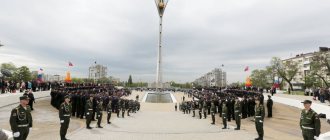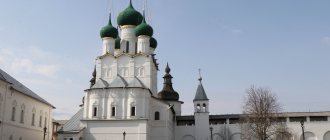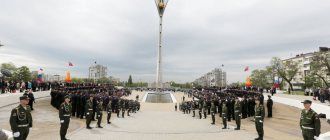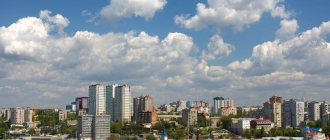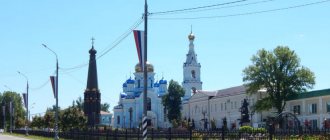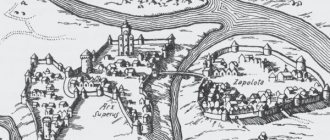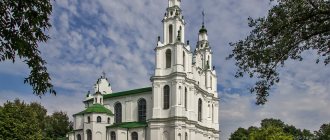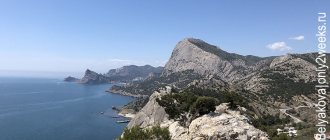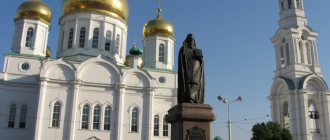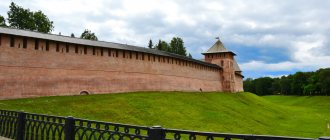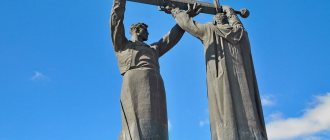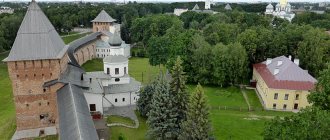On the shore of a lake with the mysterious name Nero is located one of the oldest Russian cities - Rostov the Great. Today it is part of the famous tourist route “Golden Ring of Russia”. What attracts tourists to this town with a population of thirty thousand people?
First of all, travelers are fascinated by the rich history of Rostov the Great. Thousands of tourists come to enjoy the provincial atmosphere of the outback, the melodic ringing of bells, and the discreet beauty of monasteries and churches. Let's look at the most interesting sights of the city.
If you are planning a trip for several days, read what other interesting places there are in the Yaroslavl region near Rostov. And also, which cities of the Golden Ring nearby can be included in your route.
There are many historical places in Yaroslavl and neighboring regions. The most interesting things less than a hundred kilometers from Rostov:
- Yaroslavl (80 km)
- Pereslavl-Zalessky (70 km)
- Tutaev (90 km)
- Uglich (90 km)
Rostov Kremlin
Having gone behind the fortress wall and passing by the huge and majestic Assumption Cathedral with light gray domes, which will be discussed a little later, you find yourself on the territory of the main attraction of Rostov the Great - the Kremlin. Those who find themselves here for the first time are breathtaking from the stunning view that opens up.
Ancient and beautiful, as if copied from pictures, churches and majestic buildings of the 17th century, different in their architecture, are located all around, and in the middle there is a small wonderful pond with ducks, surrounded by low green banks. Trees are planted throughout the area, and in summer there are many fragrant flowers. You can’t help but feel that you have been transported several centuries back and found yourself in an ancient and fabulously beautiful city...
The Kremlin used to be the residence of the Metropolitan of the Rostov diocese, which is why it has another name - the Metropolitan Court. This majestic architectural ensemble was built in the second half of the 17th century by order of the Rostov Metropolitan Jonah Sysoevich. According to the creators' plan, the Rostov Kremlin should resemble the Garden of Eden with a mirror pond in the center, as described in the Bible.
And turning right, you find yourself directly in a garden with numerous scree apple and pear trees, which in August-September produce delicious large fruits. A little further away there is an apothecary garden, with vegetables and healing fragrant herbs: oregano, mint, St. John's wort, calendula and many others. And here you will not leave the feeling of ringing silence, peace and happiness...
Spaso-Yakovlevsky Monastery
The next place you must visit in Rostov the Great is the Spaso-Yakovlevsky Monastery. There are several ancient Russian monasteries in the city and its surroundings, but this is the most famous of them. You can get to the monastery in two ways: along the road leading to the monastery from the city center, and along the shore of the ancient Lake Nero.
The majestic and amazingly beautiful monastery, surrounded by a white fortress wall, was founded back in the 14th century by Saint James of Rostov. Until the second half of the 17th century, all buildings in the monastery were built of wood. The first stone structure was the five-domed Trinity (Zachatievsky) Cathedral, erected in 1686 by Metropolitan Jonah Sysoevich, who had previously built the Rostov Kremlin. In addition to the Conception Cathedral, the territory of the monastery includes other architectural attractions of the city, including the Demetrius Cathedral, built at the very end of the 18th century, the three-tiered Bell Tower of the second half of the 18th century, and the Yakovlev Church, built in the first half of the 19th century. All the churches on the territory of the monastery are built in a single line, which gives the appearance of the monastery a strict and classic look.
Historical and architectural monuments of Rostov
Even the most fastidious traveler will not have any problems with what to see in Rostov. Here, at every step, you can find monuments of Russian architecture from different historical eras.
Shopping arcades
- Address: st. 50 years of October, 1. Transport stop “Kremlin”.
Just 200 years ago, Rostov was one of the largest shopping centers in the country. Suffice it to say that every spring the third largest fair in all of Russia was held here. In order for visitors and local merchants to be able to present their goods in person, trading rows were built, occupying an entire city block. At the end of the 18th century. wooden buildings were replaced with stone ones. The complex of Trade Rows acquired its final form a century later, when it was replenished with the buildings of Mytny and Gostiny Dvors. The architectural ensemble with galleries, colonnades and arcades is impressive even today.
Gymnasium building
- Address: st. Moravskogo, 6. Transport stop “Gymnasium named after. Kekina."
The architectural dominant of Moravskogo Street, leading to Kolkhoznaya Square in Rostov, is the ceremonial building of the city gymnasium. The construction of a pompous mansion, built with the money of a wealthy merchant, a wonderful philanthropist A.L. Kekin, completed in 1910. The small palace, decorated in the neoclassical style, not only added to the list of city attractions, but also became a real center of education. In addition to the usual classrooms, under its vault there was a main auditorium for 300 people, a gymnasium and even an observatory. Many educational institutions in provincial cities could then envy such equipment.
Selivanov's House
- Address: st. Okruzhnaya, 5. Transport stop “Pharmacy No. 63”.
The luxurious mansion on Okruzhnaya Street could easily fit into the ensemble of Nevsky Prospect in St. Petersburg . The Art Nouveau palace belonged to the Selivanov family of merchants before the October Revolution. The building received its current appearance after a large-scale reconstruction carried out at the beginning of the last century. Then the stone house of the Catherine era was added with two different-story wings, converging to an elegant bay window with a dome. Unfortunately, the historical interiors of the mansion have been lost, but from the outside it looks wonderful.
Bell tower of the Church of the Exaltation of the Cross
- Address: Sovetskaya Square, 19. Transport stop “Pharmacy No. 63”.
Even 150 years ago, the church in the name of the Exaltation of the Holy Cross on the main shopping square of the city was considered one of the calling cards of Rostov. However, time has not been kind to the temple. From the complex of religious buildings, only the four-tiered bell tower has survived to this day. The elegant tower, a monument of architectural classicism, was not demolished in the 30s of the last century only because the fire department, built on the ruins of the destroyed temple, needed an observation tower. Later, chimes were installed on the bell tower, which had lost its dome and cross. Looking at the tower, one can only imagine how magnificent the lost Church of the Exaltation of the Cross was.
Monument to the deer
- Address: st. Dostoevsky. Transport stop "Fevralskaya Street".
Historically, in Rostov the Great, which amazes with the abundance of architectural attractions, there were almost no monumental decorations. For a long time, rumors about the installation of a monument to Prince Vasilko in the city were actively circulated among the local community. However, the project did not come to fruition. But a bronze statue of a deer recently appeared on Obezdnoye Highway. Now the image of the proud animal adorns not only the Rostov coat of arms, but also the entrance to the city. Tourists enjoy taking pictures against the background of the monument.
3. Lake Nero
Lake Nero is a beautiful natural attraction of Rostov the Great, surrounded by green forests. The name "Nero" translates to "water" or "wetland". This is the oldest lake, over 500 thousand years old, one of the few pre-glacial reservoirs preserved in Russia. Many legends and traditions are associated with this lake.
Nero captivates with his majesty and calmness. Reeds grow along the shores, boats rock on light waves, and on weekends, despite the shallow depth, you can take a boat ride on the lake. But the most amazing views will open up if you climb one of the green hills located nearby. On the one hand, an extraordinary panorama of the fabulously beautiful Rostov Kremlin with multi-colored domes opens up, and on the other, Lake Nero stretches out in all its splendor, sparkling with golden reflections on a sunny day. In the distance you can see the domes and towers of the Spaso-Yakovlevsky Monastery, and nearby there are cute and simple wooden houses, of which there are still a lot in Rostov. Looking at all this splendor, you get the feeling that you have been transported many years ago, to an old Russian fairy tale. And again you will not leave the feeling of serene calm and happiness, which will last for a long time.
The main attractions of Rostov-on-Don - TOP-5
The almost 300-year history of the city, bearing the title of Hero, is full of bright events. Significant sights are associated with them, by which Rostov-on-Don is recognized even by those people who have never been here. Visiting them, as a rule, is possible even in 1 day.
Stele to the Soldiers-Liberators
- Address: Theater Square. Transport stop "Teatralnaya Ploshchad".
A magnificent monument dedicated to the feat of the Soviet people, who saved the world from the plague of fascism, appeared in the city in 1983. On the eve of the fortieth anniversary of the liberation of Rostov-on-Don, a monument striking in its grandeur was inaugurated.
The paired stele, rising 72 m above the ground, is crowned with a top stylized as the bow of a ship with a raster in the form of a sculpture of the goddess of victory Nike, cast in copper. On the reverse side there is a huge model of the Order of the Patriotic War. At the base, the monument is surrounded by a high relief made of pouf, within the contour of which there is a belfry of 12 bells.
Cart from Rostov
- Address: Rowing Canal Embankment. Suburban train stop "1352 km".
The refrain of an incredibly popular song in Soviet times forever linked the name of the city with the cart - a mobile firing point based on a spring crew, which was the most effective means of supporting cavalry regiments going on the attack.
For the 60th anniversary of the October Revolution, a 15-meter-high monument appeared on the hill from the southern entrance to Rostov-on-Don, depicting a quadriga of galloping horses carrying a cart with two Red Army soldiers firing at the enemy from a Maxim machine gun. Despite the fact that the plaster sculpture covered with copper sheets looks, at first glance, quite massive, its authors managed to perfectly convey the expression of the moment.
Sculpture "Rostovite"
- Address: F. Ushakov Embankment. Transport stop "Embankment".
One of the iconic sights of Rostov-on-Don and, perhaps, the main symbol of the hospitality of the friendly people inhabiting the wonderful city, is the composition “Rostovchanka”. An elegant sculpture that appeared on the F. Ushakov embankment in 1984 depicts a young beauty with gorgeous curls flowing over her shoulders, emerging with outstretched arms from the waves of the Don. Rostov Aphrodite is young, full of strength and amazingly beautiful.
Atlanta Fountain
- Address: Theater Square. Transport stop "Teatralnaya Ploshchad".
The “Atlanta” fountain, built in 1936, destroyed during the war and restored five years after its end, is considered a true decoration of the city’s main square. This wonderful building is a true masterpiece of architecture.
In the middle of the rectangular pool, from the walls of which geysers gush, there is a round stepped pedestal made of granite, “inhabited” with stone frogs and newts. The Atlanteans tower on it, holding a cup in their mighty hands. In its center there is a main nozzle with a powerful jet. In the evenings, when the multi-colored lights turn on, the fountain looks fantastic.
Church of Seraphim of Sarov
- Opening hours: daily, from 7:00 to 19:00.
- Phone: +7 863 240‑90-02.
- Website: https://www.serafim-rostov.cerkov.ru
- Address: st. Portovaya, 72. Transport stop "School".
The wonderful temple, erected with public funds and consecrated in 1911, is especially revered by Rostovites, and believers from many cities of the country strive to venerate its shrines. The images of the “Appearance of the Mother of God”, “Blessed Peter and Fevronia”, “Seraphim of Sarov” with particles of the robe and relics of the saint stored here are considered miraculous. The building of the white-stone five-domed church with an elegant bell tower is considered one of the architectural highlights of the city, and its magnificent interiors are a must-see even for convinced atheists.
Assumption Cathedral
Immediately behind the powerful fortress wall surrounding the Rostov Kremlin, you will see a majestic building with five large light gray domes, striking in its beauty and power. This is the ancient Assumption Cathedral - the most famous temple of Rostov the Great, built in the 16th century.
On sunny days, the huge domes of this majestic building, shining in the sun against the blue sky, leave a lasting impression. After admiring the beautiful and unique temple from the outside and climbing the steps, you can go inside. Divine services are held in the temple, you can light candles and venerate the icons, but active restoration work is underway inside the cathedral, and therefore most of it is not yet available for inspection.
Avraamiev Epiphany Monastery
Among the attractions of Rostov the Great, Orthodox churches and monasteries occupy an important place. One of them is the Avraamiev Epiphany Monastery. This is the oldest monastery of the city and all of Russia, supposedly founded in the 12th century by the saint of Rostov - the Monk Abraham. And since the 13th century it was first mentioned in chronicles.
At first, all the buildings of the monastery were wooden. However, in the mid-16th century, Tsar Ivan the Terrible visited the monastery. This happened on the eve of the military campaign against Kazan. Seeing the miraculous rod of Saint Abraham, located in the monastery, he asked to give the rod to him on the battlefield. After the defeat of the Tatar troops, in gratitude for the help, the tsar sent funds for the construction of a new Epiphany Cathedral, which was dedicated to the capture of Kazan. It became the first stone church built in the monastery and has survived to this day. In addition to the Epiphany Cathedral, the monastery complex includes: the Church of the Entry of the 17th century, which was rebuilt many times, and the Gate Church of St. Nicholas - it contains a shrine with the relics of St. Abraham. The monastery was visited more than once by members of the royal family; the holy righteous John of Kronstadt and paritarch Tikhon visited here.
Trinity-Sergius Varnitsky Monastery
The amazingly beautiful Trinity-Sergius Varnitsky Monastery, founded in the 15th century, is located a few kilometers from Rostov the Great. The monastery received its name in honor of the great Russian saint - St. Sergius of Radonezh, and it stands on the site where there once was a village in which St. Sergius was born. During its existence, the monastery withstood the Time of Troubles, several fires and complete ruin during the years of Soviet power. Currently, it has been completely restored and is a place of pilgrimage for many believers. Now the monastery is a metochion of the Trinity-Sergius Lavra.
Nowadays the monastery complex consists of: the restored Vvedenskaya Church, the rebuilt Trinity Cathedral with a high four-tier bell tower and the beautiful Church of St. Sergius of Radonezh, again built quite recently - in 2014, the gate church dedicated to Cyril and Mary - the parents of St. Sergius of Radonezh, the Holy Gates, St. Sergius' Well, abbot's building, refectory, gymnasium and hospice house.
Frog Princess Museum
Parents with small children should definitely visit the fairy-tale museum of the Frog Princess in Rostov the Great. The opening of this small and very interesting museum took place relatively recently - in 2012. And it is located in the guest house “Frog Princess” not far from the city center, in a nice building of the late 18th century, which was previously owned by Rostov merchants. It is not surprising that such a landmark arose in Rostov the Great, because the ancient Rostovites considered the frog a sacred creature. According to legend, many years ago a princess lived in a local swamp in the form of a frog...
A tour of the museum takes place in the form of communication, with interactive games, competitions and treats; children are told and shown the fairy tale “The Frog Princess” on exhibits. The museum has a huge collection of frogs, and at the end of the tour you can buy one of them as a gift for your child.
Excursions
Despite its small territory, the history of Rostov the Great is so rich that it will be quite difficult to prepare on your own. If you don’t want to miss anything interesting and learn more about the unusual history of the city, you should book a tour with a local professional guide:
City Park
The main recreational place for residents is the city park. It is located west of the center on the shores of Lake Nero. The green and calm park is perfect for relaxing and walking. Several years ago, its landscape was reconstructed and landscaped, in particular, more recreational and children's areas appeared.
Enamel Museum
Russians borrowed the art of decorating metal products with enamel from Byzantine craftsmen back in the 10th century. And in Rostov the Great, the craft of creating enamel developed over several centuries. A museum with a wonderful collection of such artistic products is located in the city at the Rostov Finift factory.
The museum's exposition is huge and includes about 2.5 thousand exhibits from the 18th to 20th centuries. This is the largest collection in Russia. Experienced guides will introduce you to the factory’s products, made by its outstanding craftsmen over the years, and tell you about the technologies for creating enamel. A special master class organized at the museum will allow everyone to create miniatures from enamel with their own hands.
Museum "Lukova Sloboda"
This unusual museum is located in a nice wooden house, stylized as a Slavic hut. On the ground floor of the house there is a cafe where dishes are served, which always contain onions. Here all guests will be able to try traditional Russian cuisine, as well as special onion dishes prepared according to ancient recipes.
On the second floor there is a museum telling the rich history of onion cultivation in Rostov lands. Historically, the life and culture of the inhabitants of Rostov are closely connected with onions. The museum's exposition is small, but very interesting, including samples of various varieties of onions and special tools for cultivating them. And if you visit the museum accompanied by a tour, the guide will tell you the history of growing onions in Rostov, as well as many different beliefs, traditions and rituals associated with onions. For the youngest visitors of the museum, special master classes are held on making amulets and “bags of happiness” from onions.
Where to go with children in Rostov
Travelers coming to Rostov have the opportunity to immerse themselves in the romantic atmosphere of ancient epics and legends. There are many interesting places here that definitely need to be shown to your child.
Museum "Frog Princess"
- Opening hours: daily, from 10:00 to 18:00.
- Ticket price: adult 150 rubles, children 100 rubles.
- Telephone.
- Website: https://www.carevna.net/museum_carevna.html
- Address: st. Leninskaya, 20. Transport stop "Spartak Stadium"
Rostovites are sure that the famous Frog Princess once fell in love with the luxurious water lilies of Lake Nero. This axiom even has a historical basis. According to scientific research, today's townspeople are descendants of Finno-Ugric tribes who worshiped the frog! The city has a colorful museum dedicated to the heroine of a folk tale. Young visitors are always welcome here, for whom a wonderful interactive program has been prepared with the participation of Koshchei the Immortal, Vasilisa the Wise and the Frog Princess herself in many incarnations.
City Park
- Opening hours: daily, except Mondays, from 10:00 to 22:30.
- Telephone.
- Address: recreation between Sovetskaya Square and the shore of Lake Nero. Transport stop "Sovetskaya Square".
In the first half of the 19th century. On the initiative of the local nobility and merchants in Rostov, it was decided to open the City Garden. On the recreational territory allocated by the authorities along the shore of Lake Nero, alleys, flower beds, comfortable benches, and a pier for boat trips soon appeared. A little later, a wooden building was built here for performances of touring circuses and theaters. By the end of the last century, the park complex fell into disrepair. In order to restore it to its former glory, a large-scale reconstruction was needed. After the planned works were completed in 2012, the park became much more attractive and comfortable. Here you can spend a wonderful fine day with your child, enjoying the splendor of nature. There is entertainment for children of all ages.
Alyosha Popovich Museum
- Schedule:
- Ticket price: from 50 rub. up to 300 rubles, depending on the intensity of the selected program.
- Telephone.
- Website: https://www.pleshanov-tour.ru/suvlav.php
- Address: st. Frunze, 21A. Transport stop "Polyclinic No. 1".
Do you want to take a photo next to the epic hero, treat yourself to the dishes that the Russian knights ate, and try on the armor of warriors? Then visit this wonderful museum and be sure to take your child with you! The romantic atmosphere of ancient legends is clearly felt here. Guests will enjoy an interactive tour of the heroic tower, competitions in archery and other fun activities, tea drinking, and a photo shoot. Young and adult tourists take part in a quest on the territory of the heroic farmstead and receive as a gift a clay figurine of a fairy-tale hero, which they can paint with their own hands under the guidance of a master.
You may be interested in the sights of Gavrilov-Yam, Rybinsk, Pereslavl-Zalessky, Uglich and Yaroslavl.
A trip to Rostov will bring a lot of unforgettable impressions to tourists of any age. Everything here is imbued with the spirit of ancient Orthodox Rus' - generous for friends and fierce for enemies. Perhaps this is why the most revered saints were born and lived here, the flow of pilgrims to whose relics has not stopped for many centuries.
Church of Hodegetria
And again we return to the Rostov Kremlin, on the territory of which there is one amazingly beautiful attraction - the Church of Hodegetria. This church, on the one hand, stands out against the background of the entire Kremlin ensemble, and on the other, fits surprisingly well into it. It was built later than all other Kremlin buildings - at the very end of the 17th century, in the Moscow Baroque style.
The walls of this beautiful temple with a dark gray dome are decorated with an exquisite diamond pattern, and the windows are decorated with figured stone. Particularly admirable in the interior of the church is the painting of its walls and vaults, decorated with magnificent stucco cartouches of unusual shape. Now the temple houses the museum exhibition “Gold and Glaze Shines.” In the collection presented here you can see a three-tiered iconostasis, church sculptures and a huge Gospel, as well as various exhibits in the Baroque and Rococo styles of the 17th-18th centuries, festive attire of clergy and objects used in the performance of church sacraments in the 17th-18th centuries.
The sights of Rostov the Great can be described for a very long time. Its historical and cultural heritage is difficult to overestimate. In the city center, not far from another ancient monastery of the Nativity of the Virgin Mary, you can see a small snow-white church with a beautiful front garden - the Church of St. Nicholas in Podozerie from the 18th century. The church is active, but it is open only during services. If you have time, visit this church. And a few kilometers from Rostov the Great is the ancient Boris and Gleb Monastery, dedicated to the revered Russian saints Boris and Gleb, and founded in the 14th century with the blessing of St. Sergius of Radonezh. It is difficult to convey in words the atmosphere of calm and grace that reigns in the monastery. If you have the opportunity, be sure to visit it.
You have already voted
Rostov Veliky
Video: Rostov the Great from above
general information
Rostov the Great is located on the western shore of Lake Nero. Thanks to its rich history, the city is included in the famous tourist route Golden Ring of Russia. Rostov the Great has carried its beauty and grandeur through the centuries, preserving it in hundreds of unique architectural monuments. There are 326 cultural monuments on the territory of the city, a third of which are monuments of federal significance. It’s not for nothing that a trip to Rostov (not to be confused with Rostov-on-Don) is compared to traveling in a time machine.
On the quiet streets of Rostov, time does not fly, as we are used to feeling in the everyday bustle, but flows - majestically and slowly, as in childhood. The austere and elegant monasteries, not to mention the majestic local Kremlin, seem to have come straight from the pages of school history textbooks. Or vice versa: it’s as if we found ourselves on the pages of a fairy-tale book, like the hero of the famous Soviet cartoon “Vovka in the Far Far Away Kingdom.” True, the storyline, if we continue the analogy, in Rostov the Great will unfold completely differently - with a touch on the era of the formation of Rus' and the Orthodox faith in our country. It is so exciting that it cannot be compared with any, even the best textbook.
Immersion in the special atmosphere reigning here makes it possible to escape from worries and anxieties, and, while leisurely contemplating the surrounding beauty, reflect on something deeply personal. Or, in other words, put our daily whirlwind of life on pause, arranging a weekend in this ancient city, as if straight out of the pages of fairy tales and epics, calm, but full of vivid emotions and unforgettable impressions.
History of Rostov the Great
The first written mention of Rostov the Great is contained in the Tale of Bygone Years. In a record dating back to 862, it is listed as a city owned by the Novgorod prince Rurik, who became the founder of the Rurik dynasty in Rus' and is often considered the founder of the Old Russian state. And the “first inhabitants” were the Meryans - representatives of the ancient chronicled Merya tribe, who lived in the Upper Volga region and are attributed by many researchers to the Finno-Ugric tribes.
The famous Russian philologist, linguist and historian Alexei Alexandrovich Shakhmatov believed that the inclusion of Rostov the Great in the Tale of Bygone Years under the year 862 took place in a later edition of this historical work, dating from the beginning of the 12th century. Archaeological evidence indicates that the first fortified settlement on the shores of Lake Nero, known as the Sarskoye settlement, arose in the 7th century and for a long period was, in modern terms, the capital of the Merya tribe. And the formation of the city on the right bank at the mouth of the Pizherma River, now filled up, began no earlier than the middle of the 10th century. This is confirmed by excavations at the Hour Bell in the Kremlin: the earliest dendrochronological date obtained from its results is 963.
There are different hypotheses about the time of the emergence of Rostov the Great itself. According to one version, the city arose in the pre-Slavic era. Other researchers are of the opinion that it appeared as a result of the transfer of the settlement from the pagan Sarsky settlement in the 10th century, while preserving the name “Rostov”. Interestingly, both cities - the tribal Sarskoe settlement and the princely Rostov - existed at the same time. Local historian E. Pleshanov, in turn, believes that Rostov arose at the end of the 8th century or a little earlier as a Meryan settlement, becoming during the time of Rurik a center for collecting tribute for Novgorod, while remaining a suburb of the Sarsky settlement.
The importance of Rostov as a center of the Slavs began to increase in the 920-930s due to its intensive colonization by the latter. In 989-1010 In Rostov, the young Yaroslav the Wise reigned, later the Grand Duke of Kiev.
In the second half of the 11th century, Rostov was considered one of the two main cities of the Rostov-Suzdal Principality, the territory of which became the core of modern Russia. Until the 12th century, it was divided into two “ends” (parts) – Meryan (with a pagan temple) and Russian (with a Christian church). The population of the two parts, and these were two different peoples, got along well with each other. If any threat arose from the outside, they gathered a general militia. It happened that one of the Meryans accepted Orthodox baptism. From that moment on, he became Russian and had to move to another part of the city, leaving his previous home.
In 1207, the independent Principality of Rostov arose, founded by Konstantin Vsevolodovich, the eldest son of Vsevolod the Big Nest. It quickly turned into one of the important political centers, whose influence was taken into account in other Russian principalities. At that time, Rostov the Great, one of the largest cities in the northeast, was in unprecedented prosperity, experiencing economic and cultural growth.
In the winter of 1238, hordes of the Mongol Khan Batu swept through the Vladimir-Suzdal and Rostov principalities. The squads of the principalities united to repel the Mongol-Tatars. The battle between the opponents took place in March of the following year, on the still ice-covered Sit River. However, the forces turned out to be unequal: the Russian army was completely defeated. Prince Vasilko Konstantinovich was wounded and captured. The Mongols offered the Rostov prince to take a command position in their army, but he did not want to serve the invaders, for which he paid with his life. The remains of the hero-prince are buried in the Assumption Cathedral of the city. Princess Maria, after the death of her husband, became the de facto regent for her sons, young Boris and Gleb, helping them govern the principality during the difficult times of the Mongol-Tatar yoke.
Being under the rule of the Golden Horde, Rostov, however, continued to remain one of the Russian cultural and educational centers. In the local monastery, known as the Grigorievsky Seclusion, the monks wrote books - historical Orthodox, hagiographic. At the same time, they translated foreign literature, including philosophical literature, and carried out extensive teaching work among the population. A native of the Rostov monastery, Stefan of Perm was a saint of the indigenous peoples of the Northern Urals.
Many pages of the history of Rostov the Great remain unspecified and, accordingly, controversial. Thus, according to the hypothesis of the Soviet and Russian historian Vladimir Andreevich Kuchin, the city of Rostov and the Rostov principality were divided into two parts: the eastern Borisoglebskaya (Prince Fyodor reigned in it) and the western Sretenskaya (Ustretenskaya) under the rule of Prince Constantine. The historian believes that the Sretenskaya part soon became part of the Vladimir principality, falling into complete dependence on Moscow. There is another version: according to it, in 1328 the entire Rostov principality came under the rule of Moscow.
The principality became part of Moscow under Vasily Vasilyevich II the Dark. In the 1430s, the Grand Duke's governor was sent there, and in 1473-1474. The princes sold the remnants of their princely rights in Borisoglebsk to Ivan III Kalita. Thus, Rostov completely lost its political independence, but at the same time continued to remain the largest church center in which the residence of the metropolitan was located. In 1565, Tsar Ivan the Terrible established the oprichnina in the Russian state, which became his personal inheritance. The rest of the territory was called zemshchina, governed by the Boyar Duma and territorial orders. Rostov was also included in the latter. He was part of the zemshchina until the beginning of 1569, after which he was accepted into the oprichnina.
During the Time of Troubles of 1598-1613, Rostov failed to avoid the tragic fate of many Russian cities. In 1608, it was plundered and burned by Tushin troops, whose captive was Metropolitan Filaret (Romanov), the future patriarch and father of the first tsar from the Romanov dynasty, Mikhail Fedorovich. The devastating invasion, however, was the last in the history of Rostov: the invaders did not attack the city again. In 1632-1634, the king ordered to strengthen it around the central part. The Dutch engineer Jan Cornelius Rodenburg built an earthen fortress, which later became a monument to the Old Dutch fortification system.
For many centuries Rostov remained a significant religious center of the country. The Rostov diocese was not limited to the borders of the modern Yaroslavl region. Rostov bishops were among the most influential church rulers. At the end of the 14th century they were elevated to the rank of archbishops and then metropolitans. The Rostov Metropolitanate was one of the richest in Russia.
From the end of the 18th century, Rostov the Great began to lose its position both politically and religiously. First, the center of the local diocese was moved from it to Yaroslavl, and then in 1778, as a result of the provincial reform, the city became a district center. In the second half of the 1700s and until the end of the 20th century, the city became the site of the famous Rostov Fair. In other words, having lost its religious and political significance, it retained its important position as the economic center of the Yaroslavl province. The Rostov fair was so large-scale that it was second only to the Nizhny Novgorod and Makaryevskaya fairs. At the same time, the city developed the enamel craft - the production of works of art using glassy powder and enamel.
In the second half of the 19th century, Rostov began to restore and restore the monuments of the local Kremlin. In 1883, the “Museum of Church Antiquities” opened on its territory, which remains an important cultural and scientific center to this day. In 1885, the first city water supply system with a length of 10 km appeared in Rostov. It ran from the Kotorosl River to the Rolma factory, which specialized in the production of linen fabrics. The owner of the factory, merchant Anikei Kekin, who belonged to a noble and wealthy family, subsequently bequeathed all his funds to the city, since his only son-heir died tragically. This money was used to expand the water supply system and build a gymnasium.
By the beginning of the 20th century, the city had 14.5 thousand inhabitants. This number included four schools, a women's gymnasium and an arts and crafts school. The basis of the Rostov economy was 1 plant and 21 factories. In addition, the city had 22 churches, 5 monasteries and a religious school.
The turbulent year for the entire country, 1917, with its February and October revolutions, had virtually no impact on the daily life of Rostovites. However, in the 1930s, militant atheists began vigorous activity here. As a result, one of the most ancient cities of Rus' lost many historical and religious monuments, which were destroyed and demolished. When the Great Patriotic War began, the townspeople stood up to defend their native Fatherland. About 20 city residents who fought bravely at the front were awarded the title of Hero of the Soviet Union.
In 1953, Rostov suffered from a natural disaster. A tornado that arose several kilometers northwest of it fiercely burst into the city from the direction of the railroad. On his way, he overturned two carriages with bricks and lime. Following the streets of Fevralskaya and Dostoevsky, the tornado caused serious damage to residential buildings and other buildings. While this whirlwind was raging in the city, another one was rushing towards it. Having connected, both funnels formed a powerful tornado, which was classified as F2 on the Fujita scale. The disaster directed its anger at the Rostov Kremlin: it tore off almost all of its domes, and also caused damage to two churches located on the territory - St. John the Theologian and Gregory the Theologian. After this, the tornado headed towards Lake Nero, scattering all the boats within a radius of half a kilometer and raising a column of water, the height of which reached several hundred meters. He moved along the surface of the lake for some time, “pouring out” everything that he “took” with him from the city - logs, sheets of iron and other objects. Having run wild to its heart's content, the whirlwind lost its destructive power. The damage he caused to the Rostov Kremlin was so significant that the restoration work that began, led by Vladimir Sergeevich Banige, was completed only in 1957.
In 1970, Rostov the Great became part of the Golden Ring tourist route, which runs through the ancient cities of northeastern Rus' and centers of folk crafts. At that time, a hotel was built in the city, and most of the local Kremlin was given over to the Youth Tourist Center. During Soviet times, several factories were also built in the city - a pilot plant, an optical-mechanical plant and a radio plant. They were located on the outskirts and were mainly of a defensive nature. For their needs, the appropriate infrastructure was built: a water supply and sewerage system, a gas transmission main, and a Nero electrical substation. At the same time, the city expanded into several microdistricts.
Sights of Rostov
The historical heritage of Rostov the Great is inextricably linked with the formation of the state. Here, majestic temples rise on almost every corner, and the number of monasteries is simply enormous. It may even seem that there are too many religious buildings for a city with a population of 30 thousand people. But we should not forget that every church is not just a temple, but a priceless architectural monument.
During a tour of the ancient city, it is worth visiting local museums, attending master classes on teaching ancient crafts, and purchasing authentic Russian souvenirs as souvenirs. So, what to see and where to go in Rostov the Great?
The most important attraction of the city is the Rostov Kremlin. The word “Kremlin” in the name may suggest that this is a defensive structure with fortress walls, towers and narrow loopholes, traditionally characteristic of ancient Russian cities. In fact, this is not true. The Rostov Kremlin is the residence of the metropolitan of the local diocese or, in other words, the metropolitan court. This majestic architectural complex was erected in the 17th century, since at that time Rostov no longer had strategic importance, and the Kremlin structures could hardly serve as protection against an armed attack from the outside. The entrance gates here are wide, the windows have frames, and there are simply no places for the military to conveniently position themselves in case of an attack. The architectural richness of the complex includes churches, 11 towers, “chambers” and a number of buildings of civil importance. In 1998, the Rostov Kremlin was given the status of a candidate for inclusion in the UNESCO World Heritage List. Its numerous soaring domes and covered arched passages are well known throughout the former USSR from Leonid Gaidai’s beloved comedy “Ivan Vasilyevich Changes His Profession.”
The Assumption Cathedral was built 100 years before the Kremlin, forming a single architectural ensemble with the latter. According to some sources, a wooden church stood here in the 11th century. The first stone building was built in the 1220s, during the reign of Prince Andrei Bogolyubsky. The temple building that we can see today was erected in 1512. During the restoration work, valuable frescoes dating from the 16th-17th centuries were discovered. The graves of Rostov princes and metropolitans were also found.
The belfry of the Rostov Kremlin, separate from the cathedral, which can also be seen and heard in the famous Gaidaev comedy, was erected in the second half of the 17th century. You can’t call it a typical bell tower, like every church. It is a unique architectural complex, the design of which is quite unusual - it consists of one large compartment and three smaller ones. The bells with which they are equipped have different sizes. They are combined into a system that works on the principle of a real musical instrument: the melodies they produce are known as Rostov ringing.
At the western entrance to the Rostov Kremlin there is the Gate Church of St. John the Evangelist. This grandiose architectural monument appeared during the time of Patriarch Nikon’s closest associate, Metropolitan Jonah. Domes rise above the entrance arches of the gate. The facade of this temple is connected with arches and powerful, rounded towers.
Another gate church of Rostov - Resurrection - is located above the main entrance to the metropolitan courtyard, known as the Holy Gate. The architecture of this building is characterized by the appearance of the upper part, which is practically devoid of decoration; it is simple and even a little harsh. But the lower part is richly decorated with patterns, stucco and tiles. The inside of the church is very solemn; the decoration with columns adds majesty to it. The interior decoration is also distinguished by a five-tiered iconostasis and magnificent wall paintings on the theme of the earthly life of Jesus Christ.
The Church of Hodegetria stands out from the rest of the temples of the local Kremlin with its rather original appearance, made in the Moscow Baroque style. The base of the building has the shape of a rectangle with a quadrangle attached to it. When decorating the façade, a diamond-shaped volumetric cladding technique known as diamond rustication was used. The interior design differs from the traditional one: it has molded oval cartouche frames. This church has only one dome, above which rises a figured cross.
The home church of the metropolitans was the Church of the Savior on Senya. Here the clergy not only prayed, but also lived - the porch and entrance are located on the ground floor. The building has a rectangular structure with a square quadrangle. There is also one dome on this church. The roof of the building is simple, the walls are smooth, the windows are simple in shape - no architectural frills, just sheer practicality.
The Red Chamber, a secular building of the 17th century, housed the refectory and living quarters. The most remarkable part of the building is the two-hipped porch, very elegant, with peaked roofs, leading to the second floor. The façade itself is devoid of any decorations, except for the carved window openings that stand out against its smooth background. As for the interior decoration of the premises, they are lined from floor to ceiling with tiles, and the walls are painted with frescoes.
The art gallery of the Rostov Kremlin Museum-Reserve displays works by Aivazovsky, Malevich, Shishkin, and the Museum of Enamel exhibits works of the 18th-20th centuries. The excursion is usually not limited to viewing the exhibition and telling about the history of this craft. Each visitor has the opportunity to participate in a master class and learn how to coat various products with enamel.
In 2007, in Rostov, on the territory of a wooden merchant estate on the shore of a lake, the House of Crafts museum-workshop was opened. The exhibitions are dedicated to the traditional crafts of this region. Here you can not only look, but also buy handicrafts made from various materials: birch bark, wood, ceramics, wicker, lace. You can also learn the techniques of a particular craft or simply watch how experienced craftsmen make unusual products. As you understand, the museum’s collection is constantly updated with new exhibits.
In the former merchant mansion of the late 18th century, a museum with the fabulous name “The Frog Princess” was opened in 2012, located in the guest house of the same name. Its exhibition includes 2 thousand figurines of frogs, not similar to each other in either shape or style. Why frogs? The thing is that in the Finno-Ugric tribe Merya, this inhabitant of the swamps was always revered as a sacred creature.
Another museum, located in a merchant mansion built from the 18th to the 20th centuries, is dedicated directly to the Rostov merchants using the example of the history of the local merchant family, the Kekins. It opened in 2008 in a building that was unremarkable in appearance, with a plain white facade, square windows and a roof ending in a classical portico, where a large-scale reconstruction had begun nine years earlier.
True art connoisseurs will not fail to visit the Khors art gallery, which presents collections for every taste. These include paintings by Russian artists, enamel panels, and household items of the 19th century. In addition to the permanent exhibition, the gallery organizes temporary exhibitions, thematic meetings and master classes. The old house that the gallery occupies is also of interest: it is wooden, decorated with lace trim, and the inside is very cozy and homely.
The A.L. Kekin Gymnasium, which occupies two buildings (a large one built in the classical style and a small one in the Art Nouveau style), was a fairly democratic educational institution for its time. Gymnasium students were not subject to religious or property qualifications, and this circumstance made it possible for children from different classes to study together.
Another notable attraction of Rostov the Great is the Church of Isidore the Blessed on the Ramparts, built in the 16th century. It is one of the oldest religious buildings in the city. The temple was built on the site of the grave of the Orthodox saint and holy fool Isidore the Blessed (Tverdislov). In the 17th-19th centuries, the church was reconstructed, giving it a modern look, in which the features of classicism predominate. Subsequently, no restoration or other work was carried out here, and although services were resumed in the temple in 2002, the building is in need of major repairs.
There is a place in Rostov where in ancient times there was brisk trade - Gostiny Dvor. Now here is the Church of the Savior at the Market, formerly called Ruzhnaya, since it existed on donations from merchants. The lower non-residential floor (basement) was used by traders as a warehouse for goods. The whole world collected funds for the construction of this temple, so it would not be an exaggeration to say that every Rostov family made its contribution to its construction.
The monasteries of Rostov the Great deserve special attention. One of the most famous, the Boris and Gleb Monastery, appeared near the city with the blessing of Sergius of Radonezh himself. First the Moscow princes, and then the Russian tsars, not to mention the common people, loved to visit the monastery. But the Spaso-Yakovlevsky Monastery, picturesquely located on the shore of the lake, arouses interest with its unusual combination of various architectural styles and forms. On the coast of Nero, but at the other end of Rostov, stands the Abrahamievo-Epiphany Monastery, which arose on the site of the pagan temple of Vales and is one of the oldest monuments of the city. In the 15th century, in the place where Sergius of Radonezh was born (behind the railway line), you can easily find the Trinity-Sergius Varnitsky Monastery. It is visited by both pilgrims and people far from religion. There is only one regret: the appearance of the monastery is not original; almost nothing remains of the old buildings.
Holidays and festivals
Since ancient times, in Rus' there has been a tradition of colorful farewells to winter and welcoming spring. In Rostov the Great this tradition is still alive. In February-March, the territory of the Rostov Kremlin becomes the epicenter of local Maslenitsa festivities. If you have the opportunity to attend them, be sure to take advantage - the impressions will remain in your memory for a long time! In February, the city also hosts the “At the Command of the Pike” holiday. The coincidence of the name with a Russian folk tale is not accidental - there is an assumption that the action took place here.
May is completely festive for Rostovites and guests of the city. The festival of music and crafts “Living Antiquity” gathers participants and numerous spectators in the Kremlin. In the last month of the calendar spring, the “Great Rostov Ear - X Centuries of Traditions” competition is held at the “Pike Yard”, which, by the way, has an all-Russian status. City Day also falls in May.
In July, since 2013, the “Water Show of Rostov the Great” has been held on the embankment of the City Garden. The program of events includes a parade of the Nero fleet, which is joined by owners of private vessels, as well as theatrical re-enactments and spectacular stunt performances. In the same month, the annual Rostov Enamel festival takes place in the Kremlin. In the same place, but in August, the festival of medieval culture “Rostov Action” is organized. In addition to master classes on various types of crafts, it includes a gastronomic area (theme is Lenten dishes) and a large music program.
An independent gastronomic festival is also held in the city. It is new, but has ancient roots and is called “Lukova Yarmonka”. Date and location: every September, interactive tourist. By the way, this center offers both adults and children the puppet show “At the Command of the Pike,” the historical and theatrical “Fishing Tales,” entertaining local games, and an introduction to superstitions and myths. Taking into account that there are no modern attractions and water parks in Rostov, these programs will be a godsend for families with children.
Beaches of Rostov Veliky
You can’t count on a full-fledged beach holiday in Rostov the Great, although the city is located on the shores of a picturesque and pleasant large body of water - Lake Nero. Its name, by the way, is translated from the language of one of the Finno-Ugric tribes that lived here in the old days as “swampy”, “muddy”.
The city has several equipped beaches, but you won’t be able to swim for pleasure, and there is a risk of being fined. The official website of the mayor's office directly warns that there are no places equipped for swimming on the territory of the urban settlement of Rostov. You may ask a reasonable question: what are the beaches for then? The answer is brilliantly simple: for tanning.
However, there are no hopeless situations. If your vacation in Rostov falls during the hot season, go to one of the surrounding rivers or even to the Volga, where you can not only sunbathe, but also take a dip to your heart’s content.
Cafes and restaurants
Rostov the Great is a unique opportunity to touch the origins of Rus' in every sense, including culinary. In this city, everyone will be able to discover traditional Russian cuisine and, at least for the duration of the trip, forget about pizzerias, sushi bars and steak houses, eating exclusively hearty and generous food, as if it came straight from a fairy-tale self-assembled tablecloth.
Among the local culinary delights, hand-made dumplings deserve special attention, filled not only with pork or beef, but also with fish, for example, local lake pike. Speaking about the fish riches of Lake Nero, let's not forget about pike perch, which is prepared here in a variety of variations. One of the dishes involving pike perch is called “Telnoe”. The name doesn’t say anything, so the best way to satisfy your gastronomic curiosity is to come and try it on the spot. And, of course, pike perch is used to prepare a luxurious local fish soup, to which an entire festival is even dedicated. It’s called “The Great Rostov Ear.” The event is traditionally held at the end of spring.
Local pickles also gained fame for Rostov the Great far beyond its borders. In particular, mushrooms collected in the surrounding forests. Some cafes even organize special mushroom excursions accompanied by experienced experts. As for quenching your thirst, in this ancient city you are unlikely to even remember the harmful chemical fizzy drinks with flavors and dyes. They will find a healthy and useful alternative in the form of kvass, sbitney, fruit drinks and mead.
In many local catering establishments, the theme of Ancient Rus', pre-revolutionary Russia and, of course, epics and fairy tales is played out in one way or another. This is noticeable even from the straightforward signs, not to mention the interiors in the style of a village hut or boyars' chambers. The same trend can be seen in the menu: you will be offered geese in apples, baked piglets, pancakes, pies, chicken chicken.
In addition to the unusual menu, the prices are also pleasantly surprising. A full set of Russian cuisine for two people, even in the most popular restaurant, will cost from 700 to 1100 rubles (excluding alcohol). In some establishments, the cost of set meals and business lunches starts from 250-300 rubles. At 140-180 rubles. A hearty breakfast of porridge and cheesecakes will cost you. On average, a serving of dumplings costs about the same. But fish dishes are somewhat more expensive: you will have to pay at least 360-480 rubles per serving. Of course, there are also modern fast food establishments in Rostov, the range of dishes in which is traditional. And everyone decides for himself whether he will at least temporarily give up refined food in favor of half-forgotten Russian cuisine or not.
What to bring as a souvenir
Rostov the Great belongs to the category of cities where tourists do not need to rack their brains about what to bring with them as a souvenir of the trip. Its history is so rich, and there are so many crafts and trades here that you definitely won’t return home with banal refrigerator magnets and plates.
The main pride of Rostovites is, of course, enamel. Colored enamel miniatures that decorate icons, boxes and other products are sold out by tourists with a bang. But there is a risk of running into a Chinese fake: “masters” from the Middle Kingdom have learned to copy original products so skillfully that an inexperienced traveler does not immediately notice the “stamping”, which has nothing to do with handmade work. To avoid getting a fake, pay attention to the manufacturer's mark: only five workshops and factories work in the city with enamel. It’s better to buy products in serious brand stores or souvenir shops opened at enterprises and museums.
In the vicinity of the city there are rich deposits of ceramic clay, which became the raw material for making dishes and handicrafts back in the 19th century. Local craftsmen have become so skilled in this craft that the appearance of the finished product is more reminiscent of cast iron than clay. Shabalov's workshop is one of the leading local manufacturers specializing in black-polished ceramics. Each product is a small work of art, the result of handmade work.
Rostov, like Tula, was also famous for its gingerbread. But the art of making them, alas, was lost over time. However, modern printed sweet souvenirs made locally can be found in any grocery store. Gingerbread cookies are eagerly bought up by both Rostovites and tourists.
Where to stay
There are about 25 hotels in Rostov, which can simultaneously accommodate about 1,000 guests. The level of service, as a rule, does not exceed three “stars”.
In the most inexpensive hotels, they charge from 1,400 to 1,900 rubles per night; in some establishments, this amount also includes breakfast. The middle price segment includes rooms costing 2200-3000 rubles. The most expensive price offers are 3400-5500 rubles per night. Interestingly, hotels with the highest prices do not officially position themselves as having a certain number of “stars,” but the level of service and comfort in them is quite high.
There are still places in Rostov where it may seem that the times of the Soviet Union have not yet passed. You can also find quite unusual accommodation options, starting with a room in a monastery or renting a hunting lodge on the lake, ending with accommodation in a real noble estate with a large picturesque area and its own beach.
Booking.com
Transport
Most tourists come to Rostov with the sole purpose of visiting the local attractions. Taking into account that there are as many as 324 architectural monuments in the city, about a hundred of which have federal status, traveling by local public transport will in no way make getting to know them faster or easier. Quite the contrary: some architectural monuments will simply flash outside the window of a bus or minibus.
If you came to the city on other business, for example, on a business trip or to visit relatives and friends, then public transport can be a good help. So, travel by bus or minibus within the city limits will cost 24 rubles, by tram it is slightly cheaper - 17 rubles. An alternative to them is a taxi: tourists most often order a ride to the hotel when they are delayed somewhere and return late. The average cost of a trip around the city in a checkered car is 200 rubles.
Fans of cycling will not be left out in Rostov either. The Lion hotel complex offers a bicycle rental service; an hour's rental costs 120 rubles. Don't want to spend money? Bring your bike with you - many people do this.
In summer, boat trips on Lake Nero are popular. On water excursions, small vessels like the Zarya motor ship are used. The cost of an hour-long walk for an adult passenger is 350 rubles; school-age children pay less. Some tourists rent small ships and swim in splendid isolation. An hour of such rental costs at least 6,000 rubles.
How to get there
Rostov the Great is separated from Moscow by a relatively short distance, only 200 km along the Yaroslavl highway. Under the most favorable circumstances, excluding capital traffic jams, a trip by car to one of the most famous cities of Russian antiquity will take no more than 3-4 hours.
By bus you will cover the same route in 3.5 to 4 hours. From Moscow bus terminals and bus stations, passing through Rostov, they run every day in various directions.
Traveling from Moscow to Rostov by train will take about 4 hours. About a dozen passenger trains depart from the Yaroslavl station every day. The cost of a ticket for a seated carriage starts from 567 rubles. The coupe, of course, is more expensive: 1900-3600 rubles. The local Rostov-Yaroslavsky station is located on the Northern Railway, one of the oldest railway lines in the country. However, this circumstance will not help travelers from St. Petersburg, not to mention the regions of Siberia: they will still have to travel with transfers - either in Moscow or in Yaroslavl.
It is possible to get to Rostov by train. But this option is not particularly popular, given that you have to drive for 5 hours, and even with a transfer in Aleksandrov.
